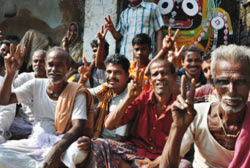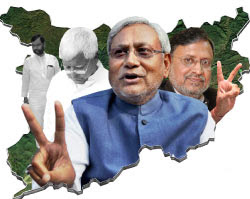51 years in exile is a long time, but not long enough to break the convictions of this man. His Holiness The Dalai Lama, in an exclusive interview with Prashanto Banerji, holds forth on why peace has a lot to do with karma, and why violence is not such a bad thing after all... So, is this really the sexiest man in the world?’ I was

sitting across the 75 year old Dalai Lama, Tenzin Gyatso, religious and secular leader of the Tibetan people and their government in exile – a celibate monk, and this rather impertinent question kept swimming around in my head like a goldfish on Gatorade. It wasn’t a question I had prepared for my interview with His Holiness, but as events transpired, it did seem a rather valid question though….
National Geographic’s Naked Science, in an answer to the question ‘What is sexy?’ came up with three pointed answers – physical attractiveness doesn’t hurt and wit sure can turn things on, but what apparently really gets them all jelly-kneed as they crawl towards you with breathless passion is an over-abundance of that most human emotion of all – compassion. To be able to empathise and love without expectation, or “attachment” as His Holiness might put it, is ostensibly the sexiest virtue of all. National Geographic said it, social commentators on late night TV repeated it and I believed it… in desperation. But if all that were true, then indeed this twinkly-eyed monk had just blown every man, from a Bieber to a Bachchan, right off the ‘sexiest man alive’ list.
I had been advised to reach on time by his representatives for the interview. And though I was meeting a Nobel Peace Prize Winner, The Dalai Lama had freely admitted to ‘feeling anger’ during interviews and so for a change, reached the lobby of his guest house in an elegant corner of South-Delhi well before time. Since I had the time, I began leafing through the pages of his book ‘An Open Heart’ and asked myself the question – is he really the ocean of benevolence that popular media makes him out to be, or just a little boy who had greatness thrust upon him which has now become a cross he often finds too heavy to bear? Or is he the shrewd smooth-talking politician and Kalchakra (a sect of Tibetan Tantric Buddhism) Master with an agenda that conspiracy theorists make him out to be? I would soon find out.
At the appointed hour, I was ushered into His Holiness’ suite and there he was, waiting. A taller man than what his photos might suggest, His Holiness was nursing a slight sniffle and was wrapped in his customary maroon robes. What struck me as I greeted him was his youthful bearing, and the colour of his hair. You could blame it on the lights in the room if I’m wrong but his eyebrows were a deep shiny black. Ditto for the downy stubble on his shaved head. He had a strong handshake and didn’t look a day older than a man in his 50s. It was a warm but formal welcome but he looked like a man who didn’t suffer fools happily. So I waved the usual disclaimer at the start… “I’m new to this… do forgive me if I happen to make mistakes”. He smiled and then with air of an indulgent grandfather, said “Don’t worry, ask what you must, but if you get nervous I’ll beat you…” and then looked at his aides and let out a happy little laugh. They smiled back politely at the two of us… Ah well, that helped...
We needed a safe start and hopefully one that made a good impression. After all, the 14th Dalai Lama must

have been giving interviews since his early teens. I sought refuge in a question I had often thought about – Why did a land supposedly as spiritually blessed as India or Tibet have to suffer and submit to invasions and oppression and dire poverty for so long? Is spiritual power no match for economic or military might? A good start I thought, but not so the Dalai Lama. “Frankly speaking, your question is due to ignorance… you are unaware of the law of karma. Buddhism, Jainism, Hinduism… these are Indian religions that believe in the law of karma… karma means action. If you neglect performing the right kind of action or do the wrong thing, you have to bear the weight of the consequences of your actions… cannot escape it. In India there was a long period of prosperity during the time of Ashoka for instance; leadership had vision and commitment to the people, and so the nation prospered but after that there was disintegration. The rajahs (kings) had no sense of responsibility for the people, serving selfish interests… and so invaders took advantage of that. Historians say that Tibet too, during the seventh and eighth century, had become a powerful nation in Central Asia and its reign had spread (from Bengal) to Kyrghystan and Afghanistan, but then there was too much devotion and prayer… not enough right action.
But you need right action. India too got its freedom through the efforts of Gandhiji, not through prayer alone. Recently at an event in Patna, the Chief Minister said that due to Buddha’s blessings, the state had progressed a lot. I replied,” and here His Holiness had a naughty glint in his eyes “…if the Buddha’s blessing were all it took, progress should have happened long long ago. It is the state where Buddha found enlightenment.” His Holiness was laughing like a little boy sharing his favourite joke. Then he gave me a conspiratorial nod and said “I told the Chief Minister that Buddha’s blessings depend entirely on the Chief Minister’s action”. And we all laughed to that…
But if the right action is so important, then what of the nations that have been the oppressors. Those that are, as we speak, incurring bad karma? “Oh yes, they will face the law of karma. That is why it is more important to feel genuine compassion and concern for the oppressor, it is they who need it far more than the oppressed… because the victim has already endured one karmic cycle… but for the perpetrator, the wheels have just started moving.”
Speaking of oppression, the Dalai Lama had surprised me once by saying in an interview that he believed that though democracy was ideal and desirable in China, it should be very gradual and staggered. Her vast and uneducated population has been used to a strong and centralised authority figure for far too long and would take time to adjust to a new sense of freedom and responsibility. But if a massive uneducated population was the bugbear of democracy, then didn’t India have the same problem as China? And I did remember school teachers from the 80s bandying around topics like ‘India needs a dictator’ and ‘Should we have martial law?’ with a fair degree of enthusiasm at that time. Of course India was in many respects a different country then, and yet even today, we’ve got to admit that our democracy is handicapped by the lack of education amongst the electorate. So aren’t we both in the same boat? Well, His Holiness didn’t think so. In fact he was a little miffed. “Silly question! India’s been a successful democracy for far too long…” Uh oh… silly or not, it was insensitive for sure. I couldn’t expect him to compare the democracy that protects him with the autocracy that sent him into exile.
By the way, speaking of miffed responses, His Holiness is known for his brutal honesty, especially amongst friends. His friend and follower, Hollywood superstar Richard Gere had invited the Dalai Lama for his photo exhibition – a collection of black and whites that he had experimented with. At the exhibition, when Gere’s friend, philosopher and guide, the reincarnation of the Buddha of Compassion (there, that word again) saw the pictures, his response was “these are really poor quality pictures, Richard!” In his own words, Richard Gere was “dying inside” when he heard the feedback. I got off lightly in comparison, I’d say.
Such honesty demands courage for it takes a brave man to tell a nation of Jews that though Adolf Hitler was a bad man who did a lot of bad things, he too must have had the seed of goodness inside him. Even an evil man can one day transform into a good man, and that’s the battle worth fighting. But it is the look in his eyes that lets him get away with it for in those eyes you see earnest compassion and a total and conscious surrender to the Buddhist ideals of love and forgiveness. You know that he would happily say the same, and more importantly feel the same way about his own enemies, those who want to pull him down for his political activism and even those who want to destroy him because he stands in their way. So if love, kindness and forgiveness are the guiding principles of an ideal life and if looking for goodness in even one’s worst enemy is a greater ideal than pulling him down, then whether it is India or Tibet, why bother with freedom? Does it matter that one is an oppressor and the other the oppressed? Couldn’t we all learn to live, love, accept and accommodate each other? While His Holiness answered this question, I began to see how one man was wearing many crowns; there’s one with thorns that must hurt and then one so heavy that it must surely weigh him down. And then there’s his light yellow hat which he is the happiest wearing…
He gave the ceiling a wistful look and then said “In

the beginning everybody was equal, sharing all they had. Then came ambition and that created leaders. That led to exploitation between people (and nations). In the beginning, both the Bolsheviks and the Chinese communists were sincere and dedicated to the cause of the people but later insecurities and fears crept in… there was tighter control and suppression. With the collapse of the Soviet Union, the Chinese leadership feared losing power as well and started relying more on the use of force. That’s unfortunate…”
So if I’m being oppressed and victimised do I respond with ahimsa or do I fight back? “That depends on the situation,” His Holiness responded. “Sometimes some limited use of violence is the only choice… that’s (he seemed to search for the right word) permissible. Once, there were 500 merchants on a ship and the leader was the reincarnation of a Buddha. Now one of the merchants wanted to kill the other 499 and take possession of all the riches and the ship. The Buddha warned him and told him not to, but when the evil merchant still persisted with his plans, the Buddha killed him. It was violence committed to save the other merchants as well as the evil one to protect him from incurring bad karma.”
So he saved that person by killing him? “Yes, since the intention was non-violent, the action was justified, like parents scolding or even rapping a child for his own good. Though even the Buddha would pay for his actions, he undertook bad karma for the greater good. On the other hand one could talk sweet and plot to cheat – here the action is non-violent but the motivation is violent and so karma too is violent. This, however, is a Buddhist point of view”. So I wasn’t the only one waving disclaimers.
It was time to go. His Holiness seemed to enjoy the conversation and wanted to continue. And the man’s sincerity and clarity of purpose was overwhelming. There was so much I had to ask. Unfortunately, there were others waiting for an audience. But before I left I had to ask him what it was like to have a whole way of life thrust upon him. He too must have felt attraction and lust. Did he feel it was wrong? How did he control it? I wasn’t sure if the question would offend him but His Holiness had a way of making you feel that he had nothing to hide and was as open to your feelings and thoughts as your best friend might be. And no matter what you say, he looked upon the world with enough compassion for any of our barbs, intended or not, to ever touch him. And his response? A very candid “Oh yes, of course (one feels it), but (I control it) with training. And when I watch a couple, I think it is nice, but then I feel there are too many problems. You first worry about finding the right partner. Then if no children, you worry. If you have children you worry about their health, education, marriage and then the same with grand children. I tell the monks and nuns this story as a consolation and I say that there’s too much worry… a monk does not need it. In the long run, a celibate’s life is very useful (laughs).”
And is that the secret of his robust health and youthful bearing? “Yes (smiles some more), and I think my mental state is quite calm and peaceful…” Then he holds my hand with such warmth and his eyes, they peered right into my soul and I was convinced he is no God, but a mere man, but what a good man and such a kind soul.
In my library there’s this forgotten book by Sam Keen called Fire in the Belly – On being a Man. It had this survey at the back where I’d spend most of my time. It had two lists of Ideal Men – one based on responses from men and the other from women. Both lists had different names all through except at the very top where both had listed Jesus and Gandhi as the ideal men, because they had virtues like love, compassion, honesty and moral courage. Now if that was the criteria, then indeed there are few in these times to hold a candle to Tenzin Gyatso, the 14th Dalai Lama. The bad news is that the top spot’s taken but the good news is that it’s time to get inspired, for these qualities, unlike wit or good looks, can be cultivated. So start giving some love and compassion… and who knows you could grow sexier yet…
For More IIPM Info, Visit below mentioned IIPM articles.IIPM Prof. Arindam Chaudhuri on Internet HooliganismPakistani Soldiers Killed in Border FightingABN AMRO seeks India bank licenceIIPM announces Anna Hazare FellowshipJapan PM Strongly Attacked, Lukewarmly Defended, Over Resignation PlansGIDF Club of IIPM Lucknow Organizes Blood Donation CampWatching porn video is not a crimeWhy your wife or girlfriend seems "off sex" of late?Domestic violence has been a silent relationship killer since time immemorial.  power quotient, their cool factor, or even their target customers. Superbikes have always enjoyed a cult position among those who have them, and have never failed to get noticed by those who don’t. And India has been no exception. Bikes like Yamaha R1, Suzuki Hayabusa and Kawasaki Ninja have been painstakingly beckoning the creed of rich, young and style conscious Indians of late. And they are not getting disappointed, despite being high on the price factor. Otherwise, it is more of a smooth ride for them since Indian home-grown manufacturers like Hero, Bajaj and TVS are still to manufacture a genuine superbike.
power quotient, their cool factor, or even their target customers. Superbikes have always enjoyed a cult position among those who have them, and have never failed to get noticed by those who don’t. And India has been no exception. Bikes like Yamaha R1, Suzuki Hayabusa and Kawasaki Ninja have been painstakingly beckoning the creed of rich, young and style conscious Indians of late. And they are not getting disappointed, despite being high on the price factor. Otherwise, it is more of a smooth ride for them since Indian home-grown manufacturers like Hero, Bajaj and TVS are still to manufacture a genuine superbike. sports segment becoming 17% in FY 10 from earlier 14%. Yamaha initially disappointed bikers as it didn’t give the owners the ‘Yamaha’ brand experience. But bygones became bygones with the launch of the R15, which helped Yamaha rebuild its sporty image. Interestingly, when Yamaha came to India with their global favourites R1 and V-Max, they sold a surprisingly high 50 units in three months. Soon, other global players realised that the Indian market has matured enough to take on these high-end machines. Players like European major Aprilla have already announced big plans to re-enter the market with their product line up. Ducati opened its second showroom last year in Gurgaon with bikes ranging from Rs 1 million to Rs 4.5 million in the portfolio. “We have received a positive response from all bike enthusiasts and it’s good to know they are excited about the Ducati brand. We feel honoured to be a part of the evolving motorcycle industry in India,” said Mirko Bordiga, CEO, Ducati, APAC.
sports segment becoming 17% in FY 10 from earlier 14%. Yamaha initially disappointed bikers as it didn’t give the owners the ‘Yamaha’ brand experience. But bygones became bygones with the launch of the R15, which helped Yamaha rebuild its sporty image. Interestingly, when Yamaha came to India with their global favourites R1 and V-Max, they sold a surprisingly high 50 units in three months. Soon, other global players realised that the Indian market has matured enough to take on these high-end machines. Players like European major Aprilla have already announced big plans to re-enter the market with their product line up. Ducati opened its second showroom last year in Gurgaon with bikes ranging from Rs 1 million to Rs 4.5 million in the portfolio. “We have received a positive response from all bike enthusiasts and it’s good to know they are excited about the Ducati brand. We feel honoured to be a part of the evolving motorcycle industry in India,” said Mirko Bordiga, CEO, Ducati, APAC. appeal in India as much as they would for the thrill and the oomph factor, to those with huge disposable incomes. Globally, the scenario is different as bikes are only used for special occasions or sports. But in India, motorcycles have become a regular mode of commuting. One would doubt that the masses would actually be able to enjoy the experience of these bikes. But fanatics have gone through thick and thin to get them nevertheless – be it by paying heavy import duties of about 113% for unregistered bikes and about 153% for registered vehicles.
appeal in India as much as they would for the thrill and the oomph factor, to those with huge disposable incomes. Globally, the scenario is different as bikes are only used for special occasions or sports. But in India, motorcycles have become a regular mode of commuting. One would doubt that the masses would actually be able to enjoy the experience of these bikes. But fanatics have gone through thick and thin to get them nevertheless – be it by paying heavy import duties of about 113% for unregistered bikes and about 153% for registered vehicles.














